How Much Does It Cost to Get Your Veins Stripped?
Varicose veins and spider veins can be uncomfortable, unsightly, and even painful. Many people struggle with swelling, throbbing, and heaviness in their legs—symptoms that can affect daily life. Fortunately, medical advancements have made vein stripping and other vein treatments safer, faster, and more effective than ever before. But before you schedule an appointment, you’re probably wondering: how much does it cost to get your veins stripped? Understanding the procedure, the costs involved, and what to expect from vein treatment doctors can help you make an informed decision about your vein health.
What Is Vein Stripping?
Vein stripping, also known as vein ligation and stripping, is a surgical procedure used to remove damaged or varicose veins from the legs. The procedure typically targets the great saphenous vein, a large vein that runs along the leg. When this vein becomes damaged, it can lead to poor blood flow and visible varicose veins.
During vein stripping, the surgeon makes small incisions in the leg to tie off and remove the affected vein. Blood flow is naturally rerouted through healthier veins, which relieves pressure, reduces swelling, and improves the leg’s appearance. Today, however, many vein treatment doctors prefer newer, less invasive alternatives—such as endovenous laser therapy (EVLT) or radiofrequency ablation (RFA)—that offer quicker recovery times.
Factors That Affect the Cost of Vein Stripping
When asking “how much does it cost to get your veins stripped?”, it’s important to understand that several factors influence the final price. These include:
1. The Type of Procedure
Traditional vein stripping is usually more expensive than minimally invasive procedures because it requires anesthesia, an operating room, and a longer recovery period. Modern treatments such as laser or radiofrequency vein ablation may cost less overall, even though the upfront cost per session might seem high.
2. The Severity of the Condition
The extent of vein damage significantly affects cost. Patients with multiple affected veins or advanced venous insufficiency may need more extensive treatment or multiple procedures, which raises the price.
3. Location and Clinic Fees
Prices can vary widely depending on where you live. For instance, treatment in a large city may be more expensive than in a smaller town due to higher facility and staff costs. Additionally, clinics that specialize in vein care may charge different fees based on their technology, experience, and reputation.
4. Insurance Coverage
In some cases, insurance may cover vein stripping if it’s considered medically necessary—such as when varicose veins cause pain, swelling, or ulcers. However, if the procedure is done for cosmetic reasons, insurance typically won’t cover the expense. It’s best to confirm coverage details with your provider and your vein treatment doctor before scheduling the procedure.
Average Cost of Vein Stripping
So, how much does it cost to get your veins stripped?
On average, vein stripping costs between $1,500 and $3,500 per leg in the United States. This price typically includes surgeon fees, anesthesia, and facility charges. However, costs can rise to $5,000 or more if complications occur or if additional procedures are required.
By comparison, minimally invasive treatments such as laser ablation or sclerotherapy can range from $400 to $2,000 per session, depending on the number of veins treated and the clinic’s location. Many patients choose these modern options because they are less painful and have shorter recovery times.
Why Consult a Vein Treatment Doctor First
Before deciding on any vein procedure, it’s essential to meet with a qualified vein treatment doctor. These specialists can diagnose the root cause of your vein issues and recommend the most effective treatment plan. During your consultation, the doctor may perform an ultrasound to assess blood flow and vein structure.
A skilled vein specialist will explain all available options, from conservative measures—such as compression stockings and lifestyle changes—to advanced treatments like endovenous ablation or microphlebectomy. This personalized approach ensures that you get the best results without paying for unnecessary procedures.
Is Vein Stripping Worth the Cost?
For many patients, the answer is yes. Vein stripping and other vein treatments can significantly improve comfort, appearance, and overall quality of life. Once problem veins are removed, symptoms such as aching, burning, and swelling often disappear. Additionally, modern techniques mean smaller incisions, minimal scarring, and faster recovery.
Although the upfront cost might seem high, the long-term benefits—reduced pain, improved circulation, and increased confidence—make it a worthwhile investment. Many vein treatment doctors also offer payment plans or financing options to make treatment more affordable.
Tips to Reduce Vein Treatment Costs
- Check insurance coverage for medical necessity.
- Compare clinics and ask for detailed quotes.
- Use pre-tax health accounts like FSA or HSA to cover expenses.
- Choose minimally invasive options if recommended by your doctor.
- Ask about package deals if multiple sessions are required.
Conclusion
Knowing how much it costs to get your veins stripped helps you plan financially and mentally for treatment. While traditional vein stripping can cost several thousand dollars, modern, less invasive options often deliver similar or better results at lower costs and with faster recovery times.
Ultimately, the best decision comes from consulting experienced vein treatment doctors who can evaluate your condition and recommend the most effective and affordable solution. Investing in your vein health today not only relieves discomfort but also restores confidence in your appearance—helping you step forward with lighter, healthier legs.


Comments
Post a Comment